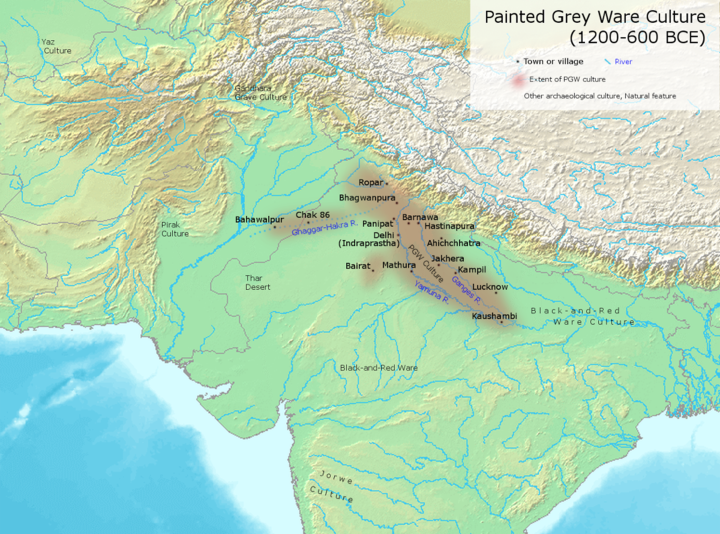Later Vedic period (1000 BC - 500 BC)
The history of the later Vedic period is based mainly on the Vedic texts which were compiled after the age of Rig Veda.
1. Later Vedic Texts
a. The Veda Samhitas
i. Sama Veda – The book of chants with hymns taken from Rig Veda. This Veda is important for Indian Music.
ii. Yajur Veda – The book consists of sacrificial rituals and formulae.
iii. Atharva Veda – This book consists of charms and spells to ward of evils and diseases
b. The Brahmanas – Consists of the explanatory part of the Vedas. Sacrifices and rituals have also been discussed in great detail.
i. Rig Veda – Aitreya and Kaushitiki Brahmana
- Consists of 1028 hymns divided into 10 mandalas (books).
- In IIIrd Mandala, Gayatri mantra is addressed to solar deity Savitri.
- X Mandala addressed to Purusha Sukta
ii. Yajur Veda – Shatapata and Taittariya
iii. Sama Veda – Panchvisha, Chandogya, Shadvinsh, and Jaiminaya
iv. Atharva Veda - Gopatha
c. The Aranyakas – Concluding portions of Brahmanas, also called as Forest texts written mainly for the hermits and students living in forests.
d. The Upanishads – Appearing at the end of the Vedic period, they criticized the rituals and laid stress on right belief and Knowledge.
Note- Satyamev Jayate has been taken from Mundaka Upanishad.
2. Vedic literature – Following the Later Vedic age, a lot of Vedic Literature was developed, inspired from the Samhitas which follow the Smriti – Literature which was written in comparison to Shruti – Word of Mouth tradition. Important texts in Smriti tradition are further subdivided into
a. Vedangas
i. Shiksha - Phonetics
ii. KalpaSutras – Rituals
- Sulva Sutras
- Grihya Sutras
- Dharma Sutras
iii. Vyakarna - Grammar
iv. Nirukta - Etymology
v. Chhandha - metrics
vi. Jyotisha - Astronomy
b. Smriti
i. Manu Smriti
ii. Yajnavalkya Smriti
iii. Narada Smriti
iv. Parashara Smriti
v. Brihaspati Smriti
vi. Katyayana Smriti
c. Mahakavyas
i. The Ramayana
ii. The Mahabharata
d. The Puranas
i. 18 Maha Puranas – Dedicated to specific deities such as Brahma, Surya, Agni, Saiva and Vaishnava. They include Bhagavata Purana, Matsya Purana, Garuda Purana etc
ii. 18 Upa Puranas – Lesser known texts
e. The Upvedas
i. Ayurveda - Medicine
ii. Gandharvaveda - Music
iii. Arthaveda - Vishwakarma
iv. Dhanurveda - Archery
f. Shad-Darshanas or Indian Philosophical Schools
i. Samkhya
ii. Yoga
iii. Nyaya
iv. Vaisheshika
v. Mimansa
vi. Vedanta
3. The PGW-Iron Phase Culture and Later Vedic Economy
The settlements covered the whole of the North India with the Ganges being the center of culture. The appearance of Iron implements in Dharwar, Gandhara and Baluchistan region from 1000 BC. Iron was called as Shyama or Krishna Ayas and was used in hunting, clearing forests etc.

a. Territorial Divisions
i. Aryavarta – North India
ii. Madhya Desa – Central India
iii. Dakshinapah – South India
b. The transition of chief source of livelihood from Pastoralists to well-settled and sedentary Agriculture based economy. Rice (Vrihi), Barley, Wheat, and Lentils were chief produce.
c. Arts and Crafts improved with the use of Iron and Copper implements. Weaving, leatherwork, pottery and carpenter’s work also made great progress.
d. The growth of Towns or Nagaras were seldom found. The Later Vedic phase didn’t develop into an urban Phase. Kaushambi and Hastinapur are called as Proto-Urban Sites.
e. Seas and Sea Voyages are also mentioned in the Vedic texts.
4. Political Organization
a. Assemblies – Popular assemblies lost their importance. The character of Sabha and Samiti changed while Vidatha disappeared. Rich nobles and chiefs started to dominate these assemblies.
i. Women were no longer allowed in these assemblies. They lost their importance gradually.
b. Formation of bigger kingdoms led to Kings becoming powerful and tribal authority becoming territorial. Rashtra indicates territory appears first in this phase
c. Though Election of the chief appears in the text, the post tends to become hereditary. But the Bharata Battle shows Kingship knows no Kinship.
d. The king performed various rituals to strengthen his powers. Some of them are
i. Ashvamedha – Unquestioned control over an area in which the royal horse ran uninterrupted.
ii. Vajapeya- Chariot race
iii. Rajasuya Sacrifice to confer supreme powers
e. Sangrihitri – An officer appointed to collect taxes and tributes
f. Even in this phase, the King did not possess a standing army and tribal units were mustered in times of war.
5. Social Organization
a. Chaturvarna System developed gradually due to the increasing power of Brahmanas as Sacrifice rituals were becoming more common. But even now the Varna system had not advanced very far.
b. The Vaishyas were the common people who paid tributes while the Brahmanas and Kshatriyas lived on the tributes collected from the Vaishyas. The three Varnas were entitled to Upanayana and the recitation of Gayatri Mantra which was deprived to Shudras.
c. Gotra started to appear with Gotra Exogamy begun to be practiced.
d. Ashramas (Brahmacharya, Grihastha, Vanaprastha, and Sannyasin) were not well established.
6. Gods, Rituals, and Philosophy
a. The cult of Brahminical Influence developed with growing rituals and sacrifices.
b. Indra and Agni lost their importance while Prajapati acquired the supreme position with Rudra and Vishnu having important positions
c. Signs of idolatry started to appear
d. People worshipped god for material reasons
e. Sacrifices became more important with sacrificial rituals and formulae accompanying sacrifices
f. The guest was called as Goghana or one who was fed on cattle.
g. Brahmans demanded golds, cloth, horses along with territories/lands as part of their sacrificial gifts.

Comments
Post a Comment
Thanks for reading my Blogs or articles